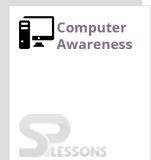 Introduction
Introduction
What is Computer Awareness?
Computer Awareness, also known as Computer Aptitude is one of the prominent sections in various recruitment related competitive exams in India. TS CAB Recruitment Computer Aptitude Quiz 9 lists some of the important questions for the preparation of Computer Awareness module. The most significant topics to be learnt for Computer Awareness module are as follows:
- History of Computers
- Computer Fundamentals
- Parts of a Computer System
- Data Processing Cycle of a Computer
- Computer Languages
- Input Devices & Output Devices
- Operating Systems
- Database Management Systems
- Microsoft Office
- Keyboard Shortcuts
- File Extensions
- Networking and Internet
- Computer Viruses
- Important Abbreviations
 Quiz
Quiz
1. In analyzing the compilation of PL/I program, the description "resolving symbolic address (labels) and generating machine language" is associated with
- A. Assembly and output
B. Code generation
C. Storage assignment
D. Syntax analysis
- A. assembler
B. translator
C. compiler
D. system software
- A. system software
B. applications software
C. an operating environment
D. an interpreter
- A. Debugger
B. Editor
C. Spooler
D. All of the above
- A. 0111EF
B. 9001E6
C. DA000F
D. 40
1. The advantage(s) inherent to using high level languages is/are:
- A. Fewer people, less management and shorter transition in learning time
B. Improved debugging capability, and superior documentation
C. A greater degree of machine independence
D. All of the above
- A. a program that automate the translation of assembly language into machine language
B. a program that accepts a program written in a high level language and produces an object program
C. a program that places programs into memory and prepares them for execution
D. is a program that appears to execute a source program as if it were machine language
- A. wires
B. gates
C. transistors
D. registers
- A. X + Y + Z
B. XY + YZ
C. X + YZ
D. X + YZ
- A. AND
B. XAND
C. XOR
D. NOR
1. How many bits are required to encode all twenty six letters ten symbols, and ten numerals?
- A. 5
B. 6
C. 2
D. 3
- A. one
B. more than one
C. two only
D. both (A) and (B)
- A. encoder
B. decoder
C. multiplexer
D. demultiplexer
- A. DTL
B. TTL
C. ECL
D. CMOS
- A. OR
B. NAND
C. XOR
D. NOR



